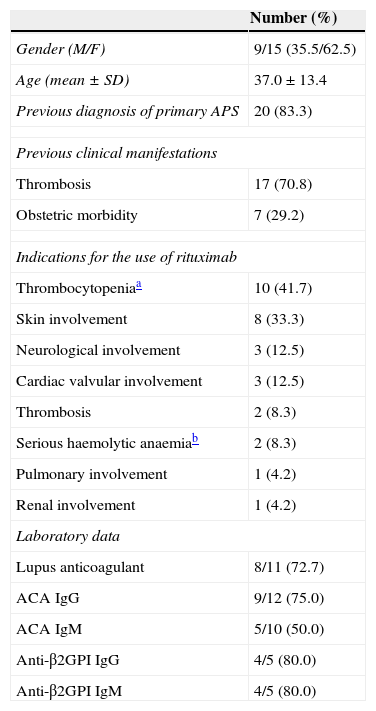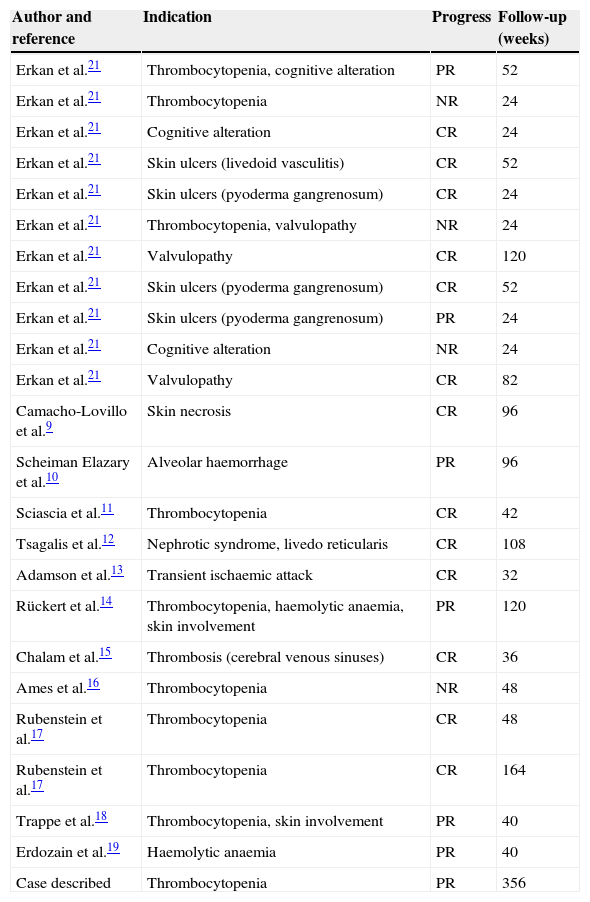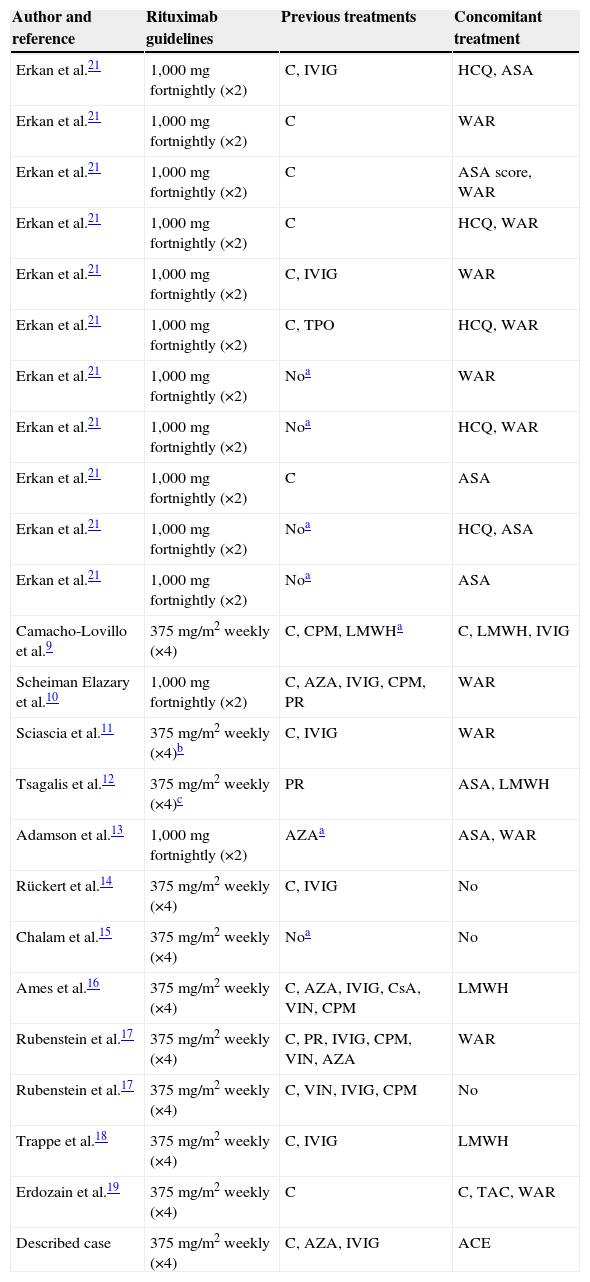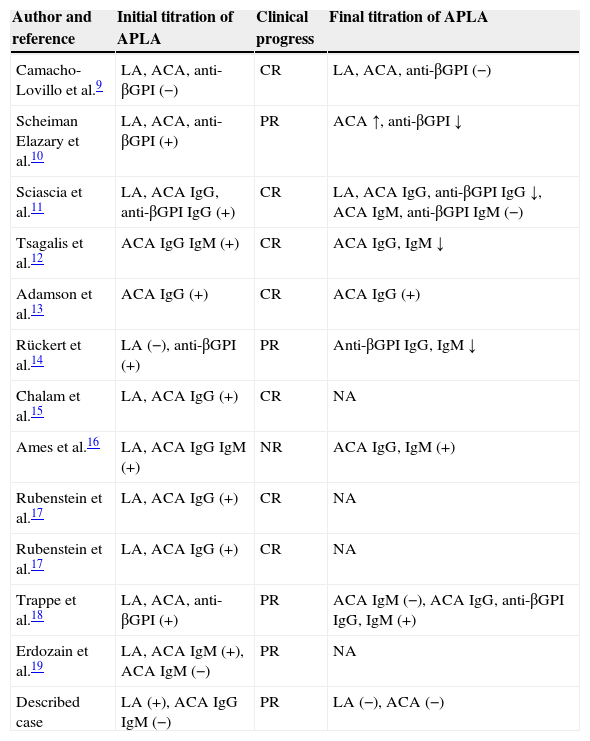Antiphospholipid syndrome (APS) is characterised by the presence of antiphospholipid antibodies (aPL) and thrombotic and/or obstetric manifestations. Patients without another associated autoimmune disease are considered to have primary APS. Some patients develop thrombosis recurrence despite anticoagulant treatment and some clinical features do not respond to standard therapy. Rituximab may be an alternative in these cases. We review the published scientific evidence on the use of rituximab in the treatment of primary APS.
Patients and methodsDescription of a case and review of the literature with descriptive analysis of the demographic, clinical, and immunologic features, treatment and outcome of patients.
ResultsWe identified 24 patients (15 women [62.5%]), with a mean age of 37.0±13.4 years. The reasons for the use of rituximab were thrombocytopenia (41.7%), skin involvement (33.3%), neurologic and heart valve involvement (12.5%), hemolytic anaemia (8.3%) and pulmonary and renal involvement (4.2%). Lupus anticoagulant was present in 72.7% of the cases, the IgG and IgM isotypes of anticardiolipin antibodies in 75 and 50%, respectively, and the anti-β2GPI (IgG and IgM) antibodies in 80% of the patients. Thirteen (54.1%) patients received two doses of 1000mg of rituximab fortnightly, 10 (41.7%) four doses of 375mg/m2 weekly and 1 (4.2%) eight doses of 375mg/m2 weekly. Eleven (45.8%) patients presented a complete clinical response, seven (29.2%) a partial response and six (25%) did not respond to rituximab. Four patients with clinical improvement presented with aPL titer decrease and in one patient, aPL levels did not change. In one patient without clinical response, aPL remained positive. A clinical-immunologic dissociation existed in two additional cases.
ConclusionsThe results obtained suggest a possible potential benefit of rituximab in the treatment of some clinical manifestations of primary APS such as thrombocytopenia, skin and heart valve involvement.
El síndrome antifosfolipídico (SAF) se caracteriza por la presencia de anticuerpos antifosfolipídicos (AAF) y complicaciones trombóticas y/o obstétricas. Cuando no se asocia a ninguna otra enfermedad autoinmunitaria recibe el nombre de SAF primario. En algunas ocasiones, el tratamiento antitrombótico no es suficiente para evitar la recurrencia trombótica, y algunas manifestaciones clínicas no responden al tratamiento estándar. Rituximab puede ser una alternativa en estos casos. Nuestro objetivo fue revisar la evidencia científica publicada del uso de rituximab en el tratamiento del SAF primario.
Pacientes y métodosDescripción de un caso propio y revisión de la literatura médica con análisis descriptivo de las características demográficas, clínicas, analíticas, terapéuticas y evolutivas de los pacientes incluidos.
ResultadosSe han identificado 24 pacientes (15 mujeres [62,5%]), con una edad media (DE) de 37,0 (13,4) años. Las indicaciones de uso de rituximab fueron trombocitopenia (41,7%), afectación cutánea (33,3%), afectación neurológica y valvular cardíaca (12,5%), anaemia hemolítica (8,3%) y afectación pulmonar y renal (4,2%). El anticoagulante lúpico fue positivo en el 72,7% de los casos, los isotipos IgG e IgM de los anticuerpos anticardiolipina en el 75 y 50%, respectivamente, y los anticuerpos anti-β2GPI (IgG e IgM) en el 80%. Trece (54,1%) pacientes recibieron 2 dosis quincenales de 1.000mg de rituximab, 10 (41,7%) 4 dosis semanales de 375mg/m2, y uno (4,2%) 8 dosis semanales de 375mg/m2. Once (45,8%) pacientes presentaron una respuesta clínica completa, 7 (29,2%) una respuesta parcial y 6 (25%) no experimentaron ningún cambio sustancial. Cuatro pacientes con mejoría clínica presentaron una reducción en el título de los AAF, y en uno, los valores no cambiaron. Un paciente sin respuesta clínica los mantuvo positivos. Existió una disociación clínico-analítica en un par de casos.
ConclusionesLos datos obtenidos evidencian un posible beneficio potencial de rituximab en el tratamiento de alguna de las manifestaciones clínicas del SAF primario, como la trombocitopenia, la afectación cutánea y la afectación valvular cardíaca.
Artículo
Comprando el artículo el PDF del mismo podrá ser descargado
Precio 19,34 €
Comprar ahora











